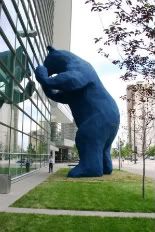 We like pretty things. We also like fiscal responsibility. We like nice buildings. We like a comfortable working environment. We travel to other parts of the state and the country and admire what “they” have. We are embarrassed by what we are lacking. While talking with travelers during a recent business trip, the topic of public art came up. Interestingly, the conversation started by talking about the perfect work environment. Can there be a connection among public art, pride and productivity? The answer is a resounding “yes.” The catch is that public art needs to be seen as an asset and not a deficit on the balance sheet.
We like pretty things. We also like fiscal responsibility. We like nice buildings. We like a comfortable working environment. We travel to other parts of the state and the country and admire what “they” have. We are embarrassed by what we are lacking. While talking with travelers during a recent business trip, the topic of public art came up. Interestingly, the conversation started by talking about the perfect work environment. Can there be a connection among public art, pride and productivity? The answer is a resounding “yes.” The catch is that public art needs to be seen as an asset and not a deficit on the balance sheet.Deficit-based public art initiatives focus on how much the installation is going to cost. This shortsightedness looks at the amount of money that can be saved by excluding the installation of art. In the midst of an economic crisis, it is natural to reduce spending in certain categories. However, even during a positive economic spike, public art is replaced with private profit. The argument against the inclusion of public art as a line item in the development costs of a new building is not because it will be too expensive. It is because it can cut into the overall profit margin.
We are constantly bombarded with deficit-based decisions. We are not going to save ourselves toward revitalization. Instead of cutting spending, budgets for new buildings should include an increased allocation of resources for public art. Let us begin asking the question: In what ways can we…?
 This leads to an asset-based view of public art. If a new building allocated one percent of the total budget toward the installation of public art on or around the property, the community would be aesthetically changed. Suddenly a ten million dollar project would include a $100,000 art installation. This could cause commercial building to become destinations or points of interest. The community would have a collection of assets.
This leads to an asset-based view of public art. If a new building allocated one percent of the total budget toward the installation of public art on or around the property, the community would be aesthetically changed. Suddenly a ten million dollar project would include a $100,000 art installation. This could cause commercial building to become destinations or points of interest. The community would have a collection of assets.When visiting with other weary travelers, many of them mentioned that the commitment to art made them feel good about their community. Furthermore, many of them said that they liked working for a company that showed a commitment to art and culture. They spoke with pride and passion. They talked about walks on during the lunch hour. They talked about staying late because the environment was pleasing. They talked about people choosing to hold meeting at locations where there was an art installation.
Think of your favorite buildings in other communities. Some may have statues. Some may have water features. Some may have murals. I hate to break it to you, but the ability to see interesting figures hidden in the random swirls of stucco does not constitute public art. Public art is purposeful and planned.
Dr. Kathryn Cramer and Hank Wasiak, authors of Change the Way You See Everything, discuss the importance of viewing situations through a much wider lens in order to gain a better view of the opportunities. With a wide lens, builders and the members of most regions would see the economic potential of public art. With a wider lens, travelers would see the collaborative relationship between the business community and the arts community. With a wider lens, everything looks better.
- So what role do developers play in increasing the amount of public art available?
- Do you think the planning departments of a city should create a new ordinance that facilitates more pubic art?
- What do you like about public art?
Right on Travis. First time I visited your blog, but won't be the last.
ReplyDeleteGreat blog, Travis. Though I have to say, I've seen quite a few artistic things in stucco swirl in my time. Ceiling tile hole patterns too.
ReplyDelete